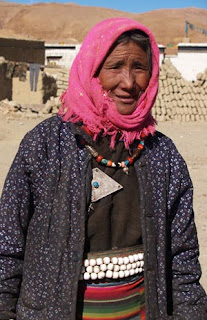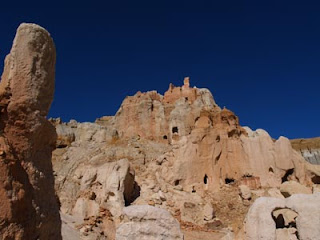January 2006.
I set off from Kathmandu in a Landcruiser with Lhakpa Sherpa and our Tibetan guide, Loga, to explore the ancient ruins of Guge, past Mount Kailash, in far western Tibet. With the pass to Guge blocked by January storms, we stayed for four days in the small village of Montser, and explored an even more exiting ruin, that of the capital of the ancient Zhangzhung Kindgdom, Kyung Lung.
Kyung Lung was a troglodite community, and capital of an empire that stretched from northern China to parts of Pakistan, from modern day Ladakh to almost as far as Lhasa. The 2000 year-old Bon kingdom pre-dated the rise of Buddhist influence in Tibet, and later became the most prominent center for Buddhist studies in the Tibetan world. Little known or explored today, the demise of Kyung Lung remains a mystery, only clues to the more recent inhabitants found scattered thoughout the caves and crumbling walls.
The site does house some incredible, ancient Buddhist cave paintings, but they have been badly damaged by the elements, and only serve to add to the intrigue of this lost civilization.
The lack of entranceways, visitors or inhabitants makes Kyung Lung an incredibly powerful and interesting site, one of the most worthwhile sites in western Tibet. Sitated on the Sutlej, the complex of caves, built into fantastic canyon walls, is close to the still promitent Bon-po Guru Gyam gompa, and to the famous pilgrimate site of Tirtapuri.
Kyung Lung is a five hour drive from the sacred Mount Kailash, and we include a trip to explore Kyung Lung on our Kailash Simikot Saga Dawa trek, 2007.
Join us!
 En route to western Tibet, we passed such spectacular sites as a 'dzong', or fortress monastery of the fifth Dalai Lama.
En route to western Tibet, we passed such spectacular sites as a 'dzong', or fortress monastery of the fifth Dalai Lama..jpg) And from above, the chortens below the gompa. This was once an important trade and pilgrimage route to the west of Tibet and Ladakh.
And from above, the chortens below the gompa. This was once an important trade and pilgrimage route to the west of Tibet and Ladakh. Tibetan still ride on wonderfully adorned horses ...
Tibetan still ride on wonderfully adorned horses ... With exquisite saddle blankets and stirrups ...
With exquisite saddle blankets and stirrups ... Past the sand dunes near Parayang, with the Himalayas framed in back ...
Past the sand dunes near Parayang, with the Himalayas framed in back ... We finally reached the sacred Mount Kailash, and pulled our Landcruiser from ice up to the axels with the help of another passing Jeep ...
We finally reached the sacred Mount Kailash, and pulled our Landcruiser from ice up to the axels with the help of another passing Jeep ....JPG) Lots of other stops for Tibetan salt-butter tea, dried meat and noodle soup kept us from freezing ...
Lots of other stops for Tibetan salt-butter tea, dried meat and noodle soup kept us from freezing ....JPG) Kailash , again, en route to the small village of Montser where we stayed at a local 'guest house' for four days.
Kailash , again, en route to the small village of Montser where we stayed at a local 'guest house' for four days..JPG) Kyang, or Tibetan wild ass, raced our Landcruiser along the way ...
Kyang, or Tibetan wild ass, raced our Landcruiser along the way ....JPG) A magnificent and rare site to see them so close to the road, and in such numbers ...
A magnificent and rare site to see them so close to the road, and in such numbers ... We met nomads bringing their yak and pashm goat herds to their winter settlements, modern Tibetan nomads living a traditional life in a harsh environment.
We met nomads bringing their yak and pashm goat herds to their winter settlements, modern Tibetan nomads living a traditional life in a harsh environment. And we met lots of pilgrims along the way ...
And we met lots of pilgrims along the way ... As well as locals, out watching their yaks ...
As well as locals, out watching their yaks ... Our 'hostess' in Parayang, not far from Kailash ...
Our 'hostess' in Parayang, not far from Kailash ... And her daughter-in-law, both dressed mostly in Tibetan garb ...
And her daughter-in-law, both dressed mostly in Tibetan garb ... And more local Tibetans in their colorful aprons and 'chubas', out grazing their sheep, goats and yaks ...
And more local Tibetans in their colorful aprons and 'chubas', out grazing their sheep, goats and yaks ... Finally in Montser, this local woman dresses in the clothes of western Tibet, similar to what they would have worn in Guge or Zhangzhung ...
Finally in Montser, this local woman dresses in the clothes of western Tibet, similar to what they would have worn in Guge or Zhangzhung ... These nomads are also clad in the leather and fur chubas of western Tibet ...
These nomads are also clad in the leather and fur chubas of western Tibet ... A woman of Kyung Lung village, about 1 1/2 hours drive from Montser, with a stunning shell belt and traditional Tibetan jewelry ...
A woman of Kyung Lung village, about 1 1/2 hours drive from Montser, with a stunning shell belt and traditional Tibetan jewelry ... The dress is generally more colorful in western Tibet.
The dress is generally more colorful in western Tibet. More villagers of Kyung Lung village (the modern day village 20 minutes from the ruins of ancient Kyung Lung).
More villagers of Kyung Lung village (the modern day village 20 minutes from the ruins of ancient Kyung Lung). Weathered faces, not used to tourists ...
Weathered faces, not used to tourists ....JPG) Kyung Lung, an amphitheatre of ruins, caves and colorful canyons ...
Kyung Lung, an amphitheatre of ruins, caves and colorful canyons ....JPG) The hike to the ruins from the bridge over the Sutlej ...
The hike to the ruins from the bridge over the Sutlej ....JPG) Canyon colors ...
Canyon colors ....JPG) Our guide from Montser, after finding an old ceramic butter lamp ...
Our guide from Montser, after finding an old ceramic butter lamp ....JPG) Spectacular holes in the rocks ...
Spectacular holes in the rocks ... A vintage 1941 pair of glacier glasses, left behind by a more recent inhabitant ...
A vintage 1941 pair of glacier glasses, left behind by a more recent inhabitant ... A wide view of the ruins and canyons, topped by a now-unreachable (at least by us) gompa ...
A wide view of the ruins and canyons, topped by a now-unreachable (at least by us) gompa ... An ochre niche with tza tzas, made from the ground-up bones after cremation, mixed with clay, and molded in metal recepticles of chortens or buddhas ...
An ochre niche with tza tzas, made from the ground-up bones after cremation, mixed with clay, and molded in metal recepticles of chortens or buddhas ... Views from inside one of the many caves ...
Views from inside one of the many caves ... The canyon-top gompa and a mushroom rock ...
The canyon-top gompa and a mushroom rock ... Beautiful Tibetan Buddhist cave paintings, this one preserved better than others ...
Beautiful Tibetan Buddhist cave paintings, this one preserved better than others ... The colors still bright but the clay cracked ...
The colors still bright but the clay cracked ... A small cave, probably used for meditation ...
A small cave, probably used for meditation ... A ragged pair of leather Tibetan boots, also left behind by a more recent cave dweller ...
A ragged pair of leather Tibetan boots, also left behind by a more recent cave dweller ... Lots of exploring, and steep drops ...
Lots of exploring, and steep drops ... A kitchen, the roof blacked by smoke ...
A kitchen, the roof blacked by smoke ... Dorje discovers an old grinding stone. We also found many mortar & pestles, a variety of tools for shearing and repairing and large piles of sheep and goat hair. And skins ...
Dorje discovers an old grinding stone. We also found many mortar & pestles, a variety of tools for shearing and repairing and large piles of sheep and goat hair. And skins ... A small niche with an ancient, crumbling prayer book and mani stone, testaments to a forgotten past ...
A small niche with an ancient, crumbling prayer book and mani stone, testaments to a forgotten past ... Massive walls give a clue to the size of these ruins ...
Massive walls give a clue to the size of these ruins ... And a shot from below gives perspective ...
And a shot from below gives perspective ... Remnents of modern Buddhist worshippers, colorful prayer flags adorn much of ancient Kyung Lung ...
Remnents of modern Buddhist worshippers, colorful prayer flags adorn much of ancient Kyung Lung ... Looking down, Kyung Lung and the Sutlej ...
Looking down, Kyung Lung and the Sutlej ... A vast network of caves ...
A vast network of caves ... The dzong ...
The dzong ... Weathered rocks, wonderful shaped and the occasional chorten ...
Weathered rocks, wonderful shaped and the occasional chorten ... A spectacular and powerful setting ...
A spectacular and powerful setting ... With a long line of mani walls leading up to the ancient, crumbling city ...
With a long line of mani walls leading up to the ancient, crumbling city ... Another prayer niche ...
Another prayer niche ... Caves, wooden door frames, rock and mud walls ...
Caves, wooden door frames, rock and mud walls ....JPG) An incredible hot spring sent up sulpherous smoke on the other side of the Sutlej ...
An incredible hot spring sent up sulpherous smoke on the other side of the Sutlej ... Looking west down the Sutlej, Kyung Lung on the right ...
Looking west down the Sutlej, Kyung Lung on the right ... The melting remains of once tall chortens mark the entraceway to Kyung Lung ...
The melting remains of once tall chortens mark the entraceway to Kyung Lung ... Thirtapuri Gompa, an hour's drive from Guru Gyam (see below) and the third most important pilgrimage site in western Tibet, after Mount Kailash & Lake Manasoravar ...
Thirtapuri Gompa, an hour's drive from Guru Gyam (see below) and the third most important pilgrimage site in western Tibet, after Mount Kailash & Lake Manasoravar ....JPG) The modern gompa of Kyung Lung village.
The modern gompa of Kyung Lung village. Guru Gyem Gompa, on the Sutlej, one of the largest and most important Bon-po gompas in Tibet. We met the Rimpoche, who had lots of knowledge of the ancient Zhangzhung Kingdom ...
Guru Gyem Gompa, on the Sutlej, one of the largest and most important Bon-po gompas in Tibet. We met the Rimpoche, who had lots of knowledge of the ancient Zhangzhung Kingdom ....JPG) Guru Gyem and a local inhabitant ...
Guru Gyem and a local inhabitant ... The cave hermitages of Guru Gyem Gompa, framed by fluttering prayer flags ...
The cave hermitages of Guru Gyem Gompa, framed by fluttering prayer flags ... And finally, at the end of a long, exciting day of exploring, following the sheep home ...
And finally, at the end of a long, exciting day of exploring, following the sheep home ...www.project-himalaya.com
For more information on our treks in Tibet, Nepal & the Indian Himalaya
